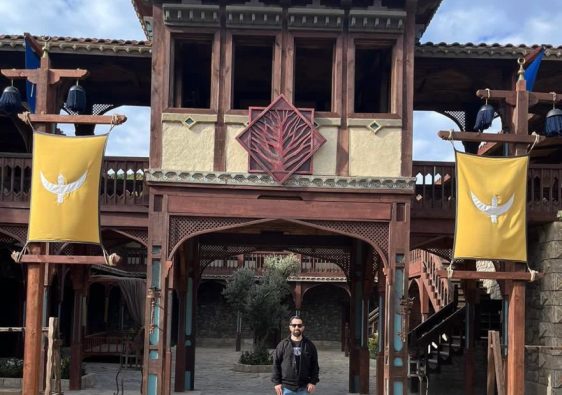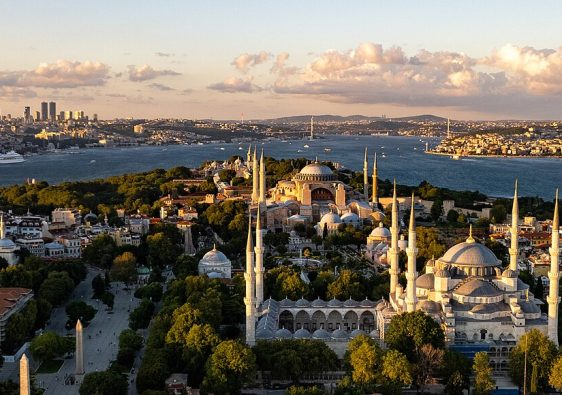Two actions by the Roman Emperor Constantine I, also known as Constantine the Great, I could be said to have changed the course of history. The first of these was Constantine’s and Licinius’ introduction of freedom of religion in 313 through the Edict of Milan, from which Christians benefited greatly. The second was the choice of Istanbul (or Byzantion, as it was named at that time) as the new capital of the Roman Empire. Originally, Istanbul was referred to using names such as the New Rome or the Second Rome, but it would become famous as Constantinople, a city adorned with magnificent buildings. This city has preserved its unique position within world history ever since its official foundation on 11 May, 330. The monumental structures erected in Istanbul in different periods contributed significantly to its fame. It cannot be denied, moreover, that Hagia Sophia’s contribution to this fame was second to none. This structure was something of a jewel in the crown of Istanbul, which was already referred to as “the Queen of Cities”.
(Büyük Konstantin adıyla da bilinen Roma imparatoru I. Konstantin’in yaptığı iki hamle tarihin seyrine doğrudan etki etmiştir. Bunlardan ilki, Licinius’la beraber 313 yılındaki Milano Fermanı ile tebaasına sağladığı din özgürlüğüdür ki Hristiyanlar bundan çokça faydalanmıştır. İkincisi ise İstanbul’un ya da o dönemki adıyla Byzantion’un Roma İmparatorluğu’nun yeni başkenti olarak seçilmesidir. Başlangıçta Yeni Roma, İkinci Roma gibi adlarla anılan şehir sonraları Konstantinopolis adıyla ün bulacak ve ihtişamlı yapılar ile donatılacaktır. Bu nadide şehir, resmî açılışı olan 11 Mayıs 330’dan günümüze kadar dünya tarihindeki değerini korumaktadır. Farklı dönemlerde yapılan abidevi yapıların bu üne katkısı yadsınamaz ve şüphesiz geçmişte “Şehirlerin Kraliçesi” olarak adlandırılan İstanbul’un tacı konumundaki Ayasofya bunda en büyük katkıya sahiptir.)
For the Christian world, which could now enjoy the fruits of religious freedom, the new capital became an important centre, and churches sprang up across the city. No less than three churches have been built in the area where Hagia Sophia is located today; not one of them, though, was constructed on the orders of the Emperor Constantine I. In fact, Eusebius, who penned Constantine I’s biography Vita Constantini, did not claim that the emperor had had such a church built. The first structure, known as “Megale Ecclesia”, meaning Great Church, was built during the reign of Emperor Constantius II. With a wooden roof and a basilica plan, this church was completed in 360.
(Din özgürlüğü ile rahat bir nefes alan Hristiyan âlemi için yeni başkent önemli bir merkez olmuş ve şehirde kiliseler yükselmeye başlamıştır. Bugün Ayasofya’nın bulunduğu alana günümüze kadar üç kilise inşa edilmiştir fakat bunların hiçbiri İmparator I. Konstantin tarafından yapılmamıştır. Zaten I. Konstantin’in hayatını (Vita Constantini) yazan Eusebius da onun böyle bir kilise yaptırdığından bahsetmez. İlk yapı, Büyük Kilise anlamına gelen Megale Ekklesia olarak biliniyordu ve İmparator II. Konstantius döneminde inşa edilmiştir. Ahşap çatılı ve bazilikal planlı bu kilise 360 yılında tamamlanmıştır. )
The first church was burned down in the course of a popular uprising at the beginning of the 5th century. The structure was rebuilt in 415, during the reign of Emperor Theodosius II. This is why the second church structure is known as “Theodosian Hagia Sophia”. However, the burning and demolition of the city during the Nika Revolt of 532 led to the eradication of all traces of this structure. This revolt, prompted by the harsh and merciless measures taken during the rule of Emperor Justinian, was brutally suppressed. Following this victory, Justinian ordered the construction of the third church that we can see today, to replace the one that had been burnt down. The architects of the new structure were Anthemius of Tralles (today’s Aydin) and Isidoros of Miletus (Milet), both mathematicians and physicists. The construction work that started in 532 was completed in just over five years, the church being inaugurated on 27 December, 537.
(5. yüzyılın başında ortaya çıkan bir halk ayaklanması sonucu birinci kilise yanmıştır. 415 yılında, İmparator II. Theodosius döneminde yapı tekrardan ayağa kaldırılmıştır. Bu sebeple ikinci kilise yapısı “Theodosius Ayasofyası” adıyla bilinmektedir. 532 yılında vuku bulan, şehrin yakılıp yıkılmasına sebebiyet veren Nika Ayaklanması sırasında, bu yapı da tarihin derinliklerine gömülmüştür. İmparator Justinianus’un yönetimi sırasında aldığı sert ve acımasız tedbirlerin neden olduğu Nika Ayaklanması kanlı bir şekilde bastırılmıştır. Kazanılan bu zafer sonrası Justinianus, yanan kilisenin yerine bugün mevcut olan üçüncü kiliseyi yaptırmıştır. Yapının mimarları, hem matematikçi hem de fizikçi olan Trallesli (Aydın) Anthemius ve Miletoslu (Milet) İsidoros’tur. 532 yılında başlatılan inşaat çalışması 5 yıldan biraz uzun bir sürede bitmiş, 27 Aralık 537 yılında kilisenin açılışı yapılmıştır.)
The architecture of Justinian’s Hagia Sophia was bold and innovative, differing significantly from that of its predecessors. It very much deserved to be dubbed a “crazy project”. Wanting to show off his power and capability through this victory monument, Justinian had building materials brought in from different parts of the world. The dome of Hagia Sophia, which was initially flattened in shape, partially collapsed on 7 May, 558, in the aftermath of the earthquake of 557. The dome was redesigned and repaired by Isidoros the Younger, nephew of the previous architect, Isidoros. With a new dome that was more bulbous than its predecessor had been, the building was opened for worship again four years later, on 24 December, 562.
(Cesur ve yenilikçi bir mimariye sahip olan Justinianus Ayasofyası ilk iki yapıdan farklıdır ve dönemi için “çılgın proje” tabirini kesinlikle hak etmektedir. Gücünü ve yapabileceklerini göstermek isteyen Justinianus, zafer nişanesi olan kilisesi için dünyanın farklı noktalarından yapı malzemeleri getirtmiştir. İlk başta basık bir şekilde tasarlanan Ayasofya’nın kubbesi, 557 yılındaki depremin de tesiriyle 7 Mayıs 558’de kısmen çökmüştür. Önceki mimarlardan İsidoros’un yeğeni olan genç İsidoros tarafından kubbe evvelkinden daha şişkin bir şekilde tasarlanarak tamir edilmiş ve 4 yıl sonra, 24 Aralık 562’de tekrar ibadete açılmıştır.)
Hagia Sophia has paid the price for this eccentric design and has had to undergo numerous repairs, starting from the century when Isidoros the Younger carried out his modifications and continuing to the present. The building has had to contend with much more than just natural disasters and inevitable deterioration in the course of time. After Constantinople was captured by the Crusaders in 1204, Hagia Sophia fell victim to heavy plunder. At that time, Hagia Sophia was undoubtedly the holiest church in Christendom, but this did not stop the Crusaders from entering it on horseback and stealing or destroying the icons and silk carpets that adorned the building’s walls. During this period, which ended in 1261, Hagia Sophia was used as a Catholic church and remained the most beautiful place of worship in the city.
(Tarih boyunca Ayasofya bu çılgın tasarımın ceremesini çekmiş ve çokça tamirat geçirmek zorunda kalmıştır. Bu tamiratlar ilk yapıldığı yüzyıldan günümüze kadar süregelmiştir. Elbette, yapının yaşadığı tek talihsizlik doğal felaketler ya da zamanla yaşanan doğal tahribat olmamıştır. Konstantinopolis’in 1204 yılında Haçlılar tarafından alınmasıyla Ayasofya ciddi bir talana maruz kalmıştır. O dönem şüphesiz Hristiyanlığın en kutsal kilisesi olan Ayasofya’ya atlarıyla giren Haçlılar duvarları süsleyen ikonaları, ipek halıları çalmış veya parçalamışlardı. Şehrin en güzel mabedi, 1261 yılında sona erecek olan bu dönem süresince Katolik kilisesi olarak kullanılmıştır.)
After the recapture of the city in 1261, Hagia Sophia once again became an Orthodox church. In 1453, however, it would undergo yet another conversion. On Friday 29 May, 1453, with the Ottoman conquest of Constantinople, the city’s most important structure was turned into a mosque and Friday prayers were performed for the first time in Hagia Sophia. The name of the building remained unchanged during the Ottoman period. People did, however, start referring to it as “Ayasofya-i Kebîr Camii”, meaning “The Great Hagia Sophia Mosque”. Over time, additions were made to the building, resulting in the emergence of a spectacular Ottoman complex. These additions included the incorporation into the mosque’s interior of a pulpit, mihrab (that indicates the direction of the Kaaba), lectern, mahfils (balconies for chanters-muezzins) and library and the appending to the exterior of impressive features such as a minaret, madrasah (school) and fountain. Structural repairs were carried out throughout the Ottoman era, culminating in those undertaken by the Fossati Brothers between 1847 and 1849 during the reign of Sultan Abdülmecid. Sheikhulislam Mekkîzâde Mustafa Âsım Efendi specified in his will that the wealth he left to the state should be used for such renovations.
(1261 yılında şehrin geri alınmasıyla Ayasofya tekrar Ortodoks kilisesi olmuştur. Ancak 1453 yılında yine bir dönüşüm geçirecektir. 29 Mayıs 1453’te İstanbul’un Osmanlılar tarafından fethi ile şehrin en önemli yapısı camiye çevrilmiş ve ilk cuma namazı burada kılınmıştır. Osmanlı döneminde yapının adı değiştirilmemiştir. Büyük Ayasofya Camii (Ulu Camii) anlamına gelen Ayasofya-i Kebîr Camii adıyla anılmaya başlanmış ve zaman içinde yapılan eklemeler ile muazzam bir Osmanlı külliyesi haline gelmiştir. Bu süreçte iç mekâna minber, mihrap, kürsü, mahfiller, kütüphane eklenirken, dış mekânda minare, medrese, şadırvan gibi yapılar boy göstermiştir. Osmanlı dönemi boyunca da yapıda tamiratlar sürmüştür. Son büyük tamirat Sultan Abdülmecid döneminde, 1847-49 yılları arasında Fossati Kardeşler’in öncülüğünde yapılmıştır. Şeyhülislâm Mekkîzâde Mustafa Âsım Efendi’nin devlete kalan serveti, vasiyeti gereğince bu işe tahsis edilmiştir.)
When the Ottoman Empire fell and Türkiye was officially proclaimed a republic in 1923, the fate of Hagia Sophia changed once more. Ankara was made the capital of the country and Istanbul was no longer known as Konstantiniyye/Constantinople. In 1934, an official decision was taken to turn Hagia Sophia, the building that symbolised Istanbul, into a museum. In the following years, under the leadership of the American Thomas Whittemore, work began on bringing to light the ornate mosaics in the building, which were hidden beneath the plaster. Over the centuries, writers have alleged that the Turks deliberately damaged the mosaics, claims that are invalidated by the reports published by Whittemore. There is no evidence that damage was deliberately done to the mosaics that emerged from beneath the plaster, and neither was there any evident intervention into the surfaces of the mosaics. Had the opposite been the case, today’s discourse on the mosaics of Hagia Sophia would be quite different.
(Osmanlı Devleti’nin çöküşü ve 1923 yılında Türkiye’de Cumhuriyet’in ilanıyla Ayasofya’nın kaderi tekrar değişmiştir. Başkent Ankara’ya taşınmış ve şehrin adı artık Konstantiniyye olmaktan çıkmıştır. Resmî olarak İstanbul olarak anılacak şehrin simge yapısı, 1934 yılında alınan kararla müzeye çevrilmiştir. Bu süreçte Amerikalı Thomas Whittemore öncülüğünde yapılan çalışmalar ile sıva altındaki figürlü mozaiklerin gün yüzüne çıkarılmasına başlanmıştır. Whittemore, bazı yazarların asırlardan beri iddia etmeye çalıştıkları “mozaiklerin Türkler tarafından kasıtlı tahrip edildiği” iddiasını yayınladığı raporlar ile geçersiz kılmıştır. Sıvaları kaldırılan mozaiklerde kasıtlı bir tahribata veya yüzlere doğrudan bir müdahaleye rastlanmamıştır. Aksi bir durum olsaydı bugün zaten mozaikleri farklı şekilde konuşuyor olurduk.)
On 10 July, 2020, the whole world witnessed another key event in the biography of Hagia Sophia: a decision taken by the Council of Ministers annulled decision number 2/1589, dated 24/11/1934, which had turned Hagia Sophia into a museum. In accordance with Article 35 of Law no. 633 on the Establishment and Duties of the Presidency of Religious Affairs (dated 22/06/1965), the Presidency of Religious Affairs took over administration of the Hagia Sophia Mosque, and the mosque itself was opened for worship. Finally, the upper gallery of Hagia Sophia was opened to the public as a museum in January, 2024.)
(10 Temmuz 2020 tarihinde Ayasofya’nın biyografisine eklenecek bir başka karara tüm dünya şahitlik etmiştir. Ayasofya’yı müzeye çeviren 24/11/1934 tarihli ve 2/1589 sayılı Bakanlar Kurulu Kararı iptal edilmiştir. Ayasofya Camii’nin yönetiminin 22/06/1965 tarihli ve 633 sayılı Diyanet İşleri Başkanlığı Kuruluş ve Görevleri Hakkında Kanunun 35. maddesi gereğince Diyanet İşlerine devredilerek ibadete açılmasına karar verilmiştir. Son olarak Ocak 2024’te ise Ayasofya’nın üst galerisi müze olarak ziyarete açılmıştır.)
Credit By : Yasin KARABACAK
web : www.yasinkarabacak.com


